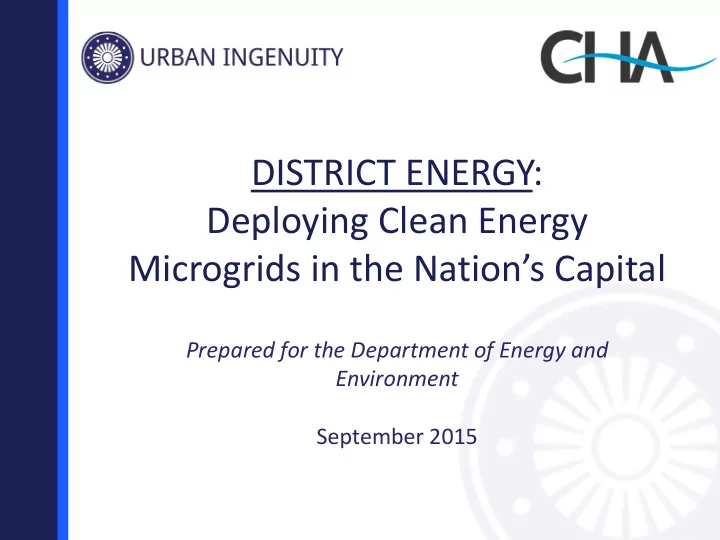

DISTRICT ENERGY: Deploying Clean Energy Microgrids in the Nation’s Capital Prepared for the Department of Energy and Environment September 2015
Microgrids 101: An Introduction 18
What are Microgrids? • Small energy system capable of balancing captive supply and demand resources to maintain stable service within a defined boundary • Combines distributed generation (DG) resources • Can work as an “island,” separate from the large grid, in case of outages 19
The Three Types of Microgrids 1. Isolated microgrids , islands, and other remote sites are not connected to a local utility grid. 2. Island-able microgrids are fully interconnected and capable of both consuming and supplying grid power, but can also maintain some level of service during a utility outage. 3. Non-synchronous microgrids are connected to utility power supplies, but aren’t interconnected or synchronized to the grid (can consume power from the grid but can’t supply it). 20
What is District Energy? • Uses steam or hot and chilled water to provide heating and cooling to many buildings • Often include combined heat and power (CHP) plants to meet both electric and thermal needs 21
Microgrid and DG Technology Cogen & Thermal: • Gas or diesel cogeneration • Combined Heat Power (CHP) Renewable Energy: • Fuel cells and microturbines • Solar Photovaltaic (PV) • Geothermal Storage and Controls: • Storage capacity (batteries, Flywheel) • Energy management and automation systems 22
Why Microgrids and District Energy? • Microgrids combine local energy assets, resources, and technologies into a system to satisfy host requirements • Provides economies of scale that are necessary to make alternative and renewable fuels practicable • More reliable, efficient, cost- effective energy infrastructure for the community 23
Operational Benefits Microgrids improve system reliability, reduce costs, and provide other operational benefits: • Cut energy demand and fuel use by integrating renewables, demand management, and reducing energy losses • Lower maintenance costs and operational expenses Improved reliability and resiliency of electricity and • thermal systems ‘Future proof’ energy systems by allowing easy • integration of newer, more efficient technology as it is developed 24
Environmental and Community Benefits Microgrids support community infrastructure and environmental sustainability: • Cut carbon emissions, other waste, and pollution • Improve grid security and system efficiency Reduces the need for new transmission and • distribution infrastructure Boost economy through infrastructure investment • and local job creation • Create competitive advantage for local businesses Back-up power for critical community infrastructure • 25
Financial Benefits Microgrids improve the bottom line for property owners and local businesses: • Reduced energy costs and more predictable energy expenditures for property owners and businesses • Displaces the need to install separate space heating and cooling and hot water systems in each building, reducing building capital costs • Retain more money in the local economy Increase investment through public private • partnerships 26
Thank You Urban Ingenuity 7735 Old Georgetown Road, Suite 600 Bethesda, MD 20814 301-280-6600 info@urbaningenuity.com 27
Recommend
More recommend